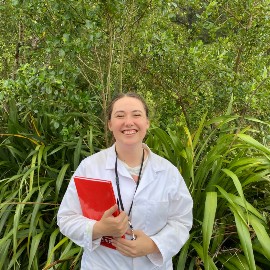Emma de Jong

Contact
Phone: 02040356840
Email: Emma.dejong@vuw.ac.nz
Office: CO531
Qualifications
BSc Victoria University of Wellington (2021)
MSc Candidate in Environmental Science
Master thesis
Title
Present-day spatial distribution of lipid biomarkers of marine microbes in the Ross Sea region, Antarctica
Supervisors
- Dr Holly Winton
- Dr Bella Duncan
- Dr Sebastian Naeher (GNS Science)
Project objectives and description
Phytoplankton (microscopic ocean plants) are the base of the marine food web and play an important role in the global carbon cycle. The Southern Ocean has an active biological pump with high production rates influencing the amount of atmospheric carbon dioxide (CO2) being dissolved into the ocean. However, our understanding of how phytoplankton in the Southern Ocean may respond to future climate change is limited by short observational records. Satellite imagery provides global coverage of continuous chlorophyll-a data over the past 25 years which can be extrapolated into primary production rates. Yet this satellite record is too short to understand the drivers of phytoplankton change. Novel proxies that provide high-resolution records of phytoplankton composition are required to evaluate how phytoplankton will respond to future change.
Molecular phytoplankton fossils (biomarkers) in Antarctic paleoclimate archives may provide a means to extend the short satellite record and understand how phytoplankton will respond to climate change, with wide-ranging consequences on Antarctic biodiversity and the global climate system. This Masters project aims to investigate the present-day spatial distribution of lipid biomarkers of phytoplankton composition in the Ross Sea region, to help interpret longer paleoclimate biomarker records of phytoplankton.
This research will be carried out through a series of objectives:
Objective 1: Compile a spatial array of samples representing present-day conditions in the Southwestern Ross Sea region.
Objective 2: Extract and analyse lipid biomarkers in the samples.
Objective 3: Identify the source of lipid biomarkers in the surface snow samples and marine sediment trap samples.
Objective 4: Analyse the spatial trends of lipid biomarkers across the Southwestern Ross Sea region. Compare the spatial distribution of biomarker concentrations with chlorophyll-a concentration satellite data.
Objective 5: Investigate what biomarkers are common to ice core and marine sediment trap sites in the Ross Sea.
